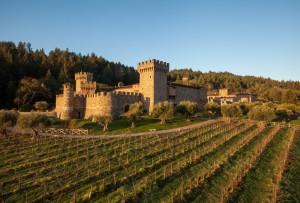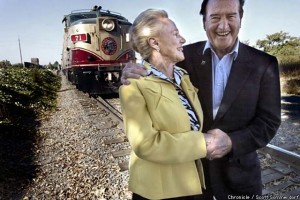Two of the most common analytical terms associated with heritage tourism are commodity and authenticity. Oftentimes, the two are in opposition with each other. Many heritage sites, for example, shy away from the authentic in order to hide portions of their history that they don’t want to share with tourists (see Charleston, SC) or to increase their appeal to tourists. On rare occasions, however, interests align and the drive to make a heritage site authentic matches the authentic experience that tourists crave. One such example is the Napa Valley Wine Train, located in Northern California.
San Francisco’s first millionaire Samuel Brannan built the tracks upon which the train ran back in 1864 so he could share the beautiful Napa countryside with his wealthy friends. After the advent of the automobile, however, the use of the railroad declined rapidly, and in 1930 passenger services were suspended. However, in 1987, several influential citizens expressed a desire to preserve the train, in the name of “their state’s cultural, food and wine heritage” (Napa Valley Wine Train). They found a benefactor in Vincent DeDomenico, co-creator of Rice-a-Roni, who restored the old Pullman cars that were still resting on the line. Two years and $20 million dollars later, The Napa Valley Wine Train was born.
The ‘rail to restoration’ has been fairly b umpy, however. Initially, the plan was to run the train as many as nine roundtrips a day, with stops along the route. Many residents of the towns located on the rail line and some of the biggest vintners, including Robert Mondavi, however mounted protests against the rail line. In a political showdown, Mondavi as well as some local businessmen and representatives forced additional regulations on DeDeoenico’s trains, and as a result 9 stops became 2 or 3 and stops were prohibited. And that’s what’s fascinating about this story. Usually, local business leaders are supportive of the tourism industry. Theoretically, the wine train would bring in more tourists, the tourists would spend their money in these towns or at these vineyards, and, the argument goes, the local economies would prosper. In this case, however, local leaders went to great lengths to protect not the authenticity of a heritage site or their own economic interests but, in their view, the best interests of their communities. As former St. Helena mayor Lowell Smith put it, “we have fought very hard in this community to not become a tourist mecca or tourist destination per se…we don’t want to be a Disneyland” (Doyle, 2002, pg. 1).
umpy, however. Initially, the plan was to run the train as many as nine roundtrips a day, with stops along the route. Many residents of the towns located on the rail line and some of the biggest vintners, including Robert Mondavi, however mounted protests against the rail line. In a political showdown, Mondavi as well as some local businessmen and representatives forced additional regulations on DeDeoenico’s trains, and as a result 9 stops became 2 or 3 and stops were prohibited. And that’s what’s fascinating about this story. Usually, local business leaders are supportive of the tourism industry. Theoretically, the wine train would bring in more tourists, the tourists would spend their money in these towns or at these vineyards, and, the argument goes, the local economies would prosper. In this case, however, local leaders went to great lengths to protect not the authenticity of a heritage site or their own economic interests but, in their view, the best interests of their communities. As former St. Helena mayor Lowell Smith put it, “we have fought very hard in this community to not become a tourist mecca or tourist destination per se…we don’t want to be a Disneyland” (Doyle, 2002, pg. 1).
This isn’t to say that their motives were completely altruistic. Cities like St. Helena (which is located at the end of the line) also depend on tourism for some of their economic wealth, which means local leaders would do anything to protect those interests. However it’s nice to see a battle of competing interests in support of the authentic experience for a change. Perhaps fights like these should be more frequent, so that we’re clamoring over what’s more right or more accurate instead of what’s going to put money in everyone’s pockets.
Sources:
http://online.ceb.com/calcases/C3/50C3d370.htm
Napa Valley wine train: The tourist train through Napa Valley. http://www.winechictravel.com/californie/oenoloisir-napa-valley-wine-train
Doyle, J. (2002). Chugging along / After 13 years, Napa Valley Wine Train rolls to a profit Retrieved March 31st 2015 from http://www.sfgate.com/bayarea/article/Chugging-along-After-13-years-Napa-Valley-Wine-2715571.php
